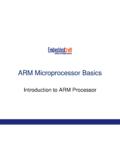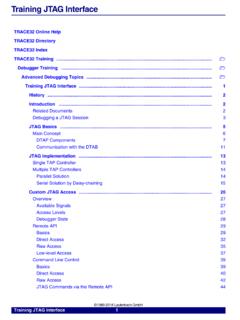Transcription of Description - Microchip Technology
1 Programmers and Debuggers EDBG USER GUIDED escriptionThe Atmel Embedded debugger (EDBG) is an onboard debugger forintegration into development kits with Atmel MCUs. In addition toprogramming and debugging support through Atmel Studio, the EDBG offersdata streaming capabilities between the host computer and the target Guide-10/2016 Table of and COM Gateway Revision Release EDBG [USER GUIDE]Atmel-42096C-EDBG_User Guide-10/201621. OverviewThe Atmel Embedded debugger (EDBG) is an onboard debugger for kits with Atmel enables the user to debug the target device without an external debugger . EDBG also bringsadditional features with a Data Gateway Interface and a Virtual COM Port for streaming of data to a hostPC. The Atmel EDBG will enumerate as a composite USB device with separate interfaces for Atmel EDBG is embedded on all Xplained Pro evaluation kits.
2 All functionality of the Atmel EDBG isnot necessarily available on all kits - the EDBG is factory configured depending on the specific kitcapabilities. The configuration is read by Atmel Studio to present the correct capabilities and simplify theuser interface. Supported extension boards connected to the kit will be detected by the EDBG and theirfeatures are reported to Atmel Features On-board programming and debugging through SWD, JTAG, and PDI Virtual COM Port interface to target via UART Data Gateway Interface (DGI) for data streaming between target MCU and PC SPI, USART, and I2C interfaces available GPIOs for accurate status indication Extension board identification Indication of power and status through LEDs Sleep mode to minimize power consumptionAtmel EDBG [USER GUIDE]Atmel-42096C-EDBG_User Guide-10/201632.
3 Programming and DebuggingThe Atmel EDBG has the ability to program and debug Atmel AVR and Atmel ARM Cortex -M corebased microcontrollers. The following interfaces are supported: Atmel ARM Cortex-M programming and debug interfaces Serial Wire Debug (SWD) Atmel megaAVR programming and debug interfaces JTAG Atmel AVR XMEGA programming and debug interfaces Program and Debug Interface (PDI)Refer to the specific kit's user guide for details on connecting the EDBG [USER GUIDE]Atmel-42096C-EDBG_User Guide-10/201643. Virtual COM PortThe EDBG features a CDC class USB interface that implements a Virtual COM Port. A UART connectedto a target device is used to enable easy communication between a computer and the following configuration options are implemented Baud Rate: Flexible and accurate settings up to 2 Mbps Parity: None, Even, Odd, Mark, Space Stop Bits: 1 bit, bits, 2 bitsThe configuration options must be specified in the terminal application, which will propagate theconfiguration to the EDBG Virtual COM Port on connection.
4 The target MCU UART must be configured tomatch the Virtual COM that the UART pins of the EDBG are tri-stated when no terminal program is connected to the VirtualCOM Port on the computer. This mechanism relies on the terminal program sending a DTR Virtual COM Port is supported by the terminal extension in Atmel Studio. Most other terminalapplications will work as EDBG [USER GUIDE]Atmel-42096C-EDBG_User Guide-10/201654. Data Gateway InterfaceThe Atmel EDBG features an interface for streaming data from the target device to a computer, called theData Gateway Interface (DGI). This is meant as an aid in debugging and demonstration of features in theapplication running on the target consists of multiple channels for data streaming. The available channels are listed in the sectionsbelow. Note that not all interfaces need to be implemented on all kits, and that different kits canimplement a different subset of these interfaces.
5 Refer to the specific kit's user guide for SPI InterfaceThe Serial Peripheral Interface (SPI) is connected through four digital signals; MOSI, MISO, SCK, andCS. The SPI is set to operate in slave mode, meaning that the target device must be set to master active low CS (Chip Select) line indicates to the SPI that it should expect data to be received and/orsent. If the master expects to receive data from the slave, it must poll for them by initiating a transfer. Allpins are tri-stated until the interface is activated from the PC and the CS line is driven is possible to configure the mode (clock phase and data setup) of the SPI module. Valid settings are0-3. The bit count for each transfer can also be set between 5 and 8 bits per normal operation, DMA will automatically buffer incoming data transfers.
6 It is also possible to enabletimestamping to get a more accurate timing of incoming data. Note that the timestamping will add anoverhead to each data transfer, and a lower maximal throughput and a longer required inter-byte delay isexpected. For sending data to the target device DMA is always USART InterfaceThe Universal Synchronous/Asynchronous Receiver/Transmitter (USART) interface is connected throughthree digital signals; RX, TX, and XCK. All pins are tri-stated until the interface is activated from the synchronous and asynchronous modes are supported. If operated in asynchronous mode, thecorrect baud rate setting must be supplied. The baud rate is flexible and is accurate up to parity settings are none, even, odd, mark, and space. Stop bit can be set to 1, , and 2 stopbits. It is possible to use a transfer size of 5-8 bits.
7 If used in synchronous mode, a clock signal must besupplied by the target normal operation, DMA will automatically buffer incoming data transfers. It is also possible to enabletimestamping to get a more accurate timing of incoming data. Note that the timestamping will add anoverhead to each data transfer, and a lower maximal throughput and a longer required inter-byte delay isexpected. For sending data to the target device DMA is always I2C InterfaceThe Two-Wire Interface (I2C) is connected to through two signals; SDA and SCL. The two-wire interfaceis set to slave mode, meaning that communication must be initiated by a target device in master interface must be enabled from the PC before communication can slave address of the I2C interface can be configured, but is default set to from the target device to I2C DGI is done by sending the slave address with the write bit,followed by the data bytes.
8 The master must poll the DGI for data by sending the slave address with theread bit. Then the DGI will send a 1 byte length, directly followed by the EDBG [USER GUIDE]Atmel-42096C-EDBG_User Guide-10/20166 Important: An I2C write transaction (could be of length zero) must take place before an I2 Cread transaction is acknowledged by the Information InterfaceThe TWI-bus can be used to request information from the EDBG. This is done by sending a specialsequence as described below. START Condition Address + W Request token START Condition (repeated start) Address + R Response .. STOP ConditionThe sequence starts by sending a normal start condition followed by an address byte (default address is0x28) with the RW bit cleared. Then a request token identifying the requested information is , a received byte would be put into the DGI buffer, but a repeated start will trigger the EDBG toparse the received token.
9 Then an address with the RW bit set. The EDBG will then start to push therequested data onto the TWI-bus. All response bytes must be ACKed by the master, and the final bytemust be Extension BoardsToken: 0xE1 The EDBG has 10 pins designated for extension board identification. These pins are sampled on power-up and the extension board identification information is stored. This information can be retrieved by usingthe Extension Boards first part of the response from this request is a 2-byte BE (1st byte is MSB) extension map containinginformation of which extension slots are populated. A '1' in bit 0 of the extension map means that EXT1 ispopulated, a '0' means not populated. If there are extension modules present the 64-byte content of eachof the ID chips is sent. It will start with EXT1. If the extension is present it will send the content, otherwiseno data is : Extension boards are available in EXT2 and EXT5.
10 The response will be: 0x00 (Extension map MSB) 0x12 (Extension map MSB) 0x41 'A' (First byte in EXT2 ID content) 0x74 't' (Second byte) 0x6D 'm' (Third byte) 0x65 'e' (Fourth byte) 0x6C 'l' (Fifth byte) 0x53 'S' (Sixth byte) .. Remaining 58 bytes 0x41 'A' (First byte in EXT5 ID content) 0x74 't' (Second byte)Atmel EDBG [USER GUIDE]Atmel-42096C-EDBG_User Guide-10/20167 0x6D 'm' (Third byte) .. Remaining 61 bytes 0x00 (End of data) Kit DataToken: 0xD2 The EDBG has 256 bytes for storing kit-specific data such as MAC address, calibration values, etc. Seethe kit documentation for details on how the data is organized. The information can be retrieved by usingthe Kit Data token. Note that not all kits have kit-specific data, and the entire section will read as sending the token, the stored kit-specific data will be sent byte-by-byte, starting with location 0, untila stop condition is GPIO InterfaceUp to four General Purpose Input/Output (GPIO) signals are connected to DGI.
















